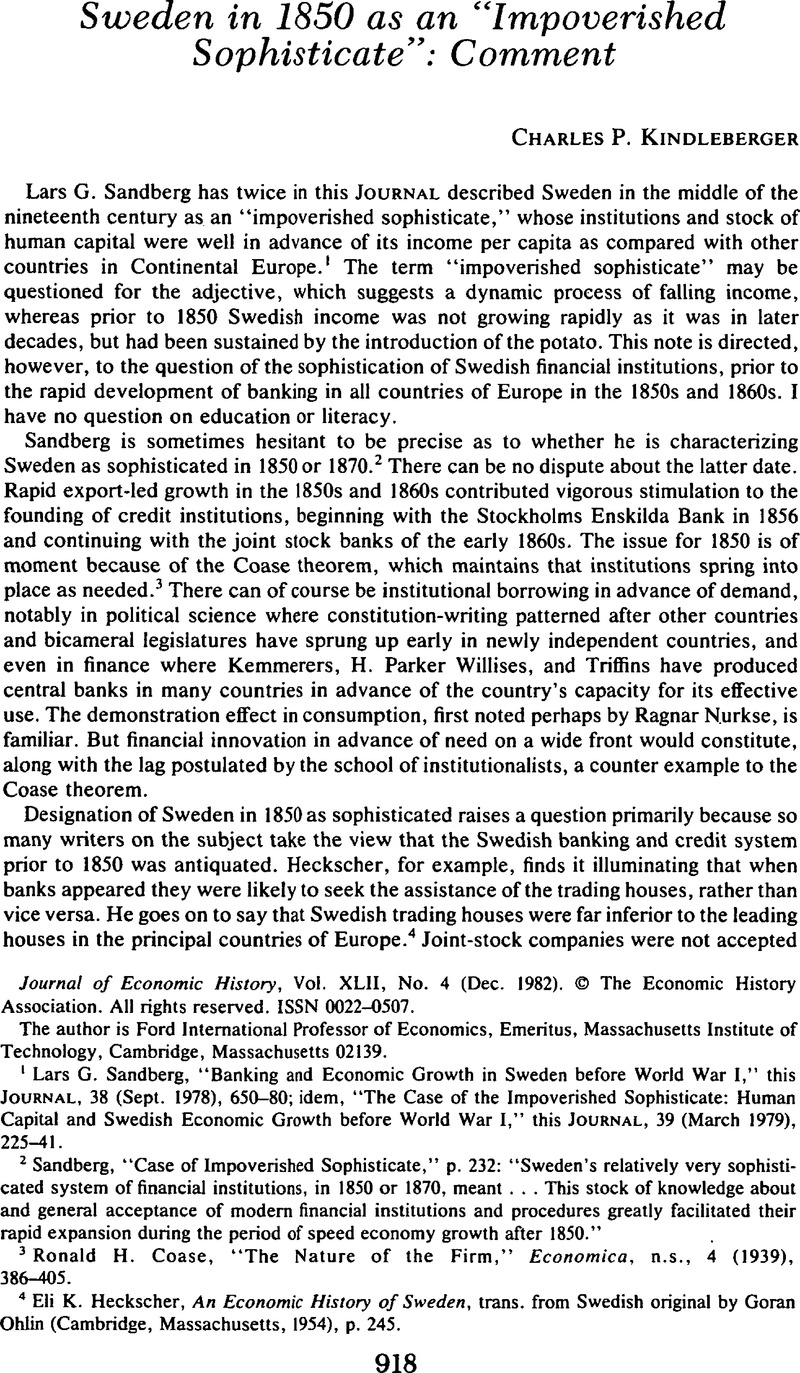Article contents
Sweden in 1850 as an “Impoverished Sophisticate”: Comment
Published online by Cambridge University Press: 03 March 2009
Abstract

- Type
- Notes and Discussion
- Information
- Copyright
- Copyright © The Economic History Association 1982
References
1 Sandberg, Lars G., “Banking and Economic Growth in Sweden before World War I,” this JOURNAL, 38 (09 1978), 650–80;Google Scholaridem, “The Case of the Impoverished Sophisticate: Human Capital and Swedish Economic Growth before World War I,” this JOURNAL., 39 (March 1979), 225–41.Google Scholar
2 Sandberg, “Case of Impoverished Sophisticate,” p. 232: “Sweden's relatively very sophisticated system of financial institutions, in 1850 or 1870, meant … This stock of knowledge about and general acceptance of modern financial institutions and procedures greatly facilitated their rapid expansion during the period of speed economy growth after 1850.”Google Scholar
3 Coase, Ronald H., “The Nature of the Firm,” Economica, n.s., 4 (1939), 386–405.CrossRefGoogle Scholar
4 Heckscher, Eli K., An Economic History of Sweden, trans. from Swedish original by Ohlin, Goran (Cambridge, Massachusetts, 1954), p. 245.Google Scholar
5 Ibid., p. 247.
6 Ibid.
7 Ibid., p. 249.
8 Fridlizius, Gunnar, Swedish Corn Exports in the Free Trade Era, Patterns in the Oars Trade, 1850–1880 (Lund, 1957), p. 266.Google Scholar
9 Ibid., pp. 205, 207.
10 Söderlund, E. F., Swedish Timber Exports, 1850–1950, A History of the Swedish Timber Trade Edited for the Swedish Wood Exporters Association (Uppsala, 1952), p. 198.Google Scholar
11 Samuelsson, Kurt, From Great Power to Welfare State (London, 1968), p. 198.Google Scholar
12 Hovde, B. J., The Scandinavian Countries, 1720–1865: The Rise of the Classes (1943; reprint ed., Port Washington, New York, 1972), pp. 241–42.Google Scholar
13 Montgomery, Arthur G., The Rise of Modern Industry in Sweden (London, 1939), p. 126.Google Scholar
14 Gasslander, Olle, History of the Stockholms Enskilda Bank to 1914 (Stockholm, 1962), p. 7.Google Scholar
15 Ibid., p. 21.
16 Heckscher, Economic History of Sweden, pp. 88–90.Google Scholar
17 Flux, A. W., The Swedish Banking System, (Washington, D.C., 1910), p. 23.Google Scholar
18 Gasslander, History of Stockholms Enskilda Bank, p. 10.Google Scholar
19 Flux, Swedish Bank System, p. 2.Google Scholar
20 Sandberg, “Banking and Economic Growth,” Table 2, p. 661.Google Scholar
21 See especially Fridlizius, Swedish Corn Exports, and Söderlund, Swedish Timber Exports. The financing of iron exports by Gothenburg dealers lending to ironmasters is discussed in Adamson, Rolf, “Finance and Marketing in the Swedish Iron Industry, 1800–1860,” Scandinavian Economic History Review, 16, no. 1 (1968), esp. pp. 54, 76, 94.CrossRefGoogle Scholar
22 Gasslander, History of Stockholms Enskilda Bank, p. 11.Google Scholar
- 3
- Cited by




